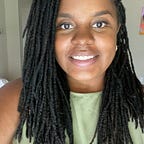In Re-Imagining Equitable Learning, This Is Not a Time to Hold Back
How STRIVE Prep — RISE is on the move towards a future of learning that puts young people at the helm
There is a spirit of inquiry and improvement that undergirds all the work STRIVE Prep — RISE is doing to reimagine education. They are thinking about the way school has traditionally been done, and asking themselves how to build something wholly new, and better. How do they ensure that across all levels of their organization students aren’t seen as empty vessels to fill, but instead school is treated as a space to learn with? How do they ensure teachers aren’t lecturing for 45 minutes, but students are engaged as co-creators in their learning?
After talking with Samson Patton, 11th and 12th grade English Language Arts teacher; Anna Steed, debate coach and English teacher; and Elisha Roberts, principal, it became clear that RISE staff is a group of educators invested in both reinvention and responsiveness.
“For some demographics, school has already been re-imagined,” Steed says. “We visited World School — they’ve reimagined high school. From classes to teachers to set-up. For us it’s about reimagining schools for schools that get nothing.” The idea of reinvention isn’t new for all communities. We see this in the disparate rates of access to learning pods, independent schools with collaborative structures, and community learning experiences for affluent students. But RISE wants to reinvent schools for learners who don’t traditionally have access to these types of reimagined spaces.
Based on feedback from empathy interviews, RISE conducts beginning-of-year programming called Portrait of a Phoenix (the phoenix is their mascot). They host this week-long session each year, in which students are in mixed grades and take the entire week to learn about education in a historical context. This allows students to navigate a range of experiences and expertise in their conversations with one another.
Additionally, RISE conducts an annual program called Intersession, in which students work as co-learners alongside peers and teachers. This also takes place in mixed-grade cohorts, and happens largely in Socratic seminar-style conversations. In one Socratic seminar during a recent Intersession, students were discussing mass incarceration. They got to the point that they were asking questions such as, “Is this week worth it? Are we going to move the needle at all? What are we really going to do?” In response to these questions, one student said, “A lot of the things you’re saying remind me of the white moderate — things aren’t going to change so let’s just let it be.’” It is moments like this, in which learners are able to context one another’s ideas in larger realities and patterns of thinking, and in which they have the space to critically respond.
Learners embracing this type of perspective on the world comes from RISE opening up spaces for learners to learn alongside each other, not to be positioned simply as consumers of a teacher’s knowledge. What’s beautiful about this type of learning, Robert notes, is that students are talking about an academic subject, but not in isolation from how that learning impacts their lives. Beyond Portrait of a Phoenix and Intersession, classes like their Life 101 Civics course give students a fuller understanding of real world issues. They engage in simulations such as: what if your car broke down, or you broke a leg, or you’re applying for an apartment, and trying to navigate all the systems that come with these issues: what do you do in each of these situations?
This responsiveness asks them to take into account the legacy of schooling that many students’ parents and caregivers have experienced — often a legacy of not being valued or seen. How do they correct some of the harm that has been done with school and people’s relationship to school?
At RISE, they are also trying to build tools that other educators can use. Steed is currently working with colleagues on a social justice curriculum that she hopes to share more broadly than their RISE team. “We want any school or district to pick it up and know it was grown in a social justice garden,” Steed says. “We’ve color-coded 60–70 different resources that fall under Black Studies, Latino Studies, US History, Math, and so on. We’ve highlighted where you can put what into what curriculum and the cross-curricular advantages that come from teaching that. We hope we are making learning stick across different contexts.”
It is clear that RISE is wary of silver-bullet approaches to reinventing learning. Yes, their network is one-to-one with computers, Patton mentions, but that isn’t the whole solution. It isn’t as simple as any one solution. At RISE, they are working to find multi-faceted solutions to the problems that young people face. They are asking questions like, “What does it mean to prepare young people for the world? How do we rethink all of these systems that schools have accepted as how it has to be? How does this spirit of innovation live in daily actions, and in every space?”
They are fully on the move, rebuilding and reinventing what it means to be a learner in the 21st century. “We are not holding back,” Steed says, “because now is not a time to hold back.”
